Pic story: inheritor of Guangzhou embroidery
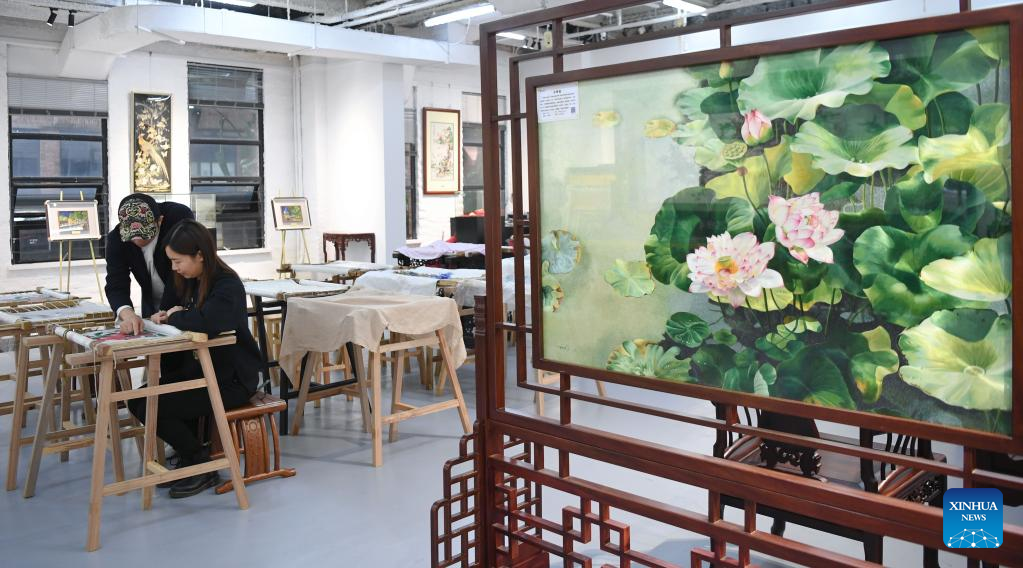
Wang Xinyuan teaches an apprentice at his studio in Liwan District of Guangzhou, south China's Guangdong Province, Dec. 6, 2022. Cantonese embroidery is one of the four famous embroideries in China. Guangzhou embroidery, part of Cantonese embroidery, dates back to the Tang Dynasty (618-907) and has a history of more than 1,000 years.
Boasting of over 30 kinds of stitches, Guangzhou embroidery is well known for complicated composition, vivid image, rich colour and lustre, and varied styles. In May of 2006, it was listed as one of the national-level intangible cultural heritages in China. Wang Xinyuan, a representative inheritor of Guangzhou embroidery, has been engaged in the walk for over 20 years. He not only inherits the tradition, but also seeks for innovation. In 1982, Wang was born in a tailor family in Wuning County of east China's Jiangxi Province. Due to the influence of his parents, he could darn his own clothes at ten years old. He started to know embroidery from his aunt when he was thirteen and systematically studied Guangzhou embroidery at a Cantonese embroidery institute in Foshan of south China's Guangdong in 2001. Three years of work-study life made him fall in love with the art. "It's not only that I choose Guangzhou embroidery, it also chooses me, " Wang said. Over the years, Wang has tried to make his own way in the inheriting of the craft, creating artworks with distinguishing styles. In his embroideries, he has adopted methods which are usually used in photography, oil paintings and traditional Chinese paintings. Besides traditional themes such as flowers and birds, silk cotton and lichee, Wang has also created Guangzhou embroidery on bronze wares, famous paintings and portraits. His efforts and exploration have been widely recognized with his artworks winning gold medals time and again in national-level competitions. In order to integrate the craft into people's daily life, Wang also sets up a team to develop creative cultural products on Guangzhou embroidery such as desk lamps, facial masks, scarves, ties, fans and pillows, making the craft affordable by common people. In recent years, Wang has brought his craft to over ten schools to give lessons for students there, cultivating their love and taste for the traditional art. He has also accepted apprentices in rural areas, helped women start their own careers, and taught skills for people with disabilities. For him, passing on Guangzhou embroidery needs to combine modern concepts with the tradition, "It's only innovation that gives life to the traditional art," Wang said. (Xinhua/Deng Hua)
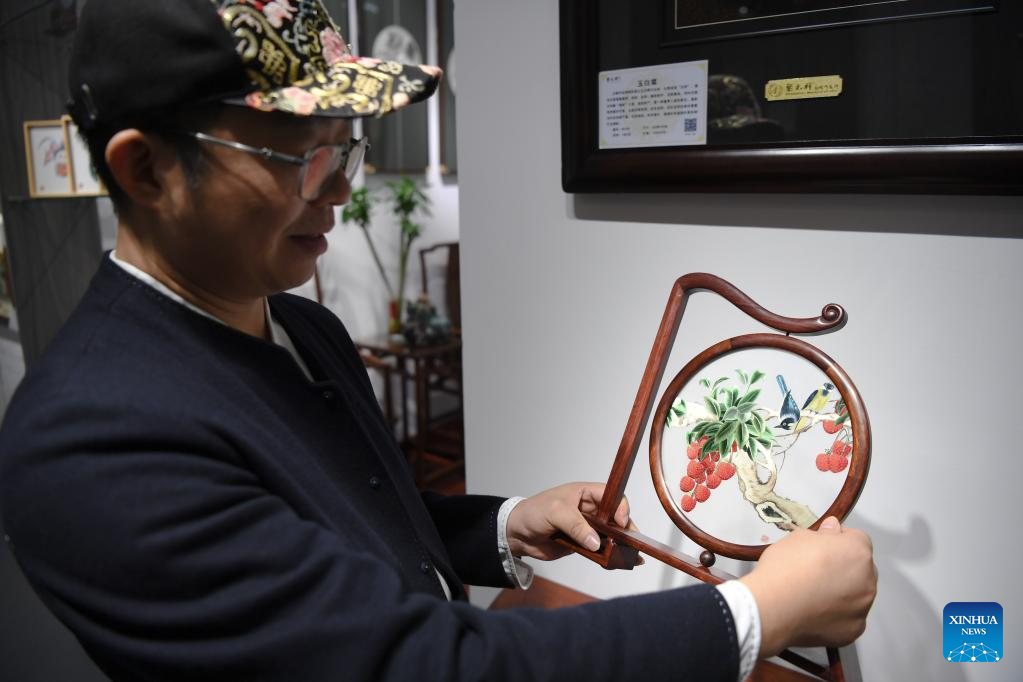
Wang Xinyuan shows a piece of traditional Guangzhou embroidery artwork at his studio in Liwan District of Guangzhou, south China's Guangdong Province, Dec. 6, 2022. Cantonese embroidery is one of the four famous embroideries in China. Guangzhou embroidery, part of Cantonese embroidery, dates back to the Tang Dynasty (618-907) and has a history of more than 1,000 years. Boasting of over 30 kinds of stitches, Guangzhou embroidery is well known for complicated composition, vivid image, rich colour and lustre, and varied styles. In May of 2006, it was listed as one of the national-level intangible cultural heritages in China. Wang Xinyuan, a representative inheritor of Guangzhou embroidery, has been engaged in the walk for over 20 years. He not only inherits the tradition, but also seeks for innovation. In 1982, Wang was born in a tailor family in Wuning County of east China's Jiangxi Province. Due to the influence of his parents, he could darn his own clothes at ten years old. He started to know embroidery from his aunt when he was thirteen and systematically studied Guangzhou embroidery at a Cantonese embroidery institute in Foshan of south China's Guangdong in 2001. Three years of work-study life made him fall in love with the art. "It's not only that I choose Guangzhou embroidery, it also chooses me, " Wang said. Over the years, Wang has tried to make his own way in the inheriting of the craft, creating artworks with distinguishing styles. In his embroideries, he has adopted methods which are usually used in photography, oil paintings and traditional Chinese paintings. Besides traditional themes such as flowers and birds, silk cotton and lichee, Wang has also created Guangzhou embroidery on bronze wares, famous paintings and portraits. His efforts and exploration have been widely recognized with his artworks winning gold medals time and again in national-level competitions. In order to integrate the craft into people's daily life, Wang also sets up a team to develop creative cultural products on Guangzhou embroidery such as desk lamps, facial masks, scarves, ties, fans and pillows, making the craft affordable by common people. In recent years, Wang has brought his craft to over ten schools to give lessons for students there, cultivating their love and taste for the traditional art. He has also accepted apprentices in rural areas, helped women start their own careers, and taught skills for people with disabilities. For him, passing on Guangzhou embroidery needs to combine modern concepts with the tradition, "It's only innovation that gives life to the traditional art," Wang said. (Xinhua/Deng Hua)
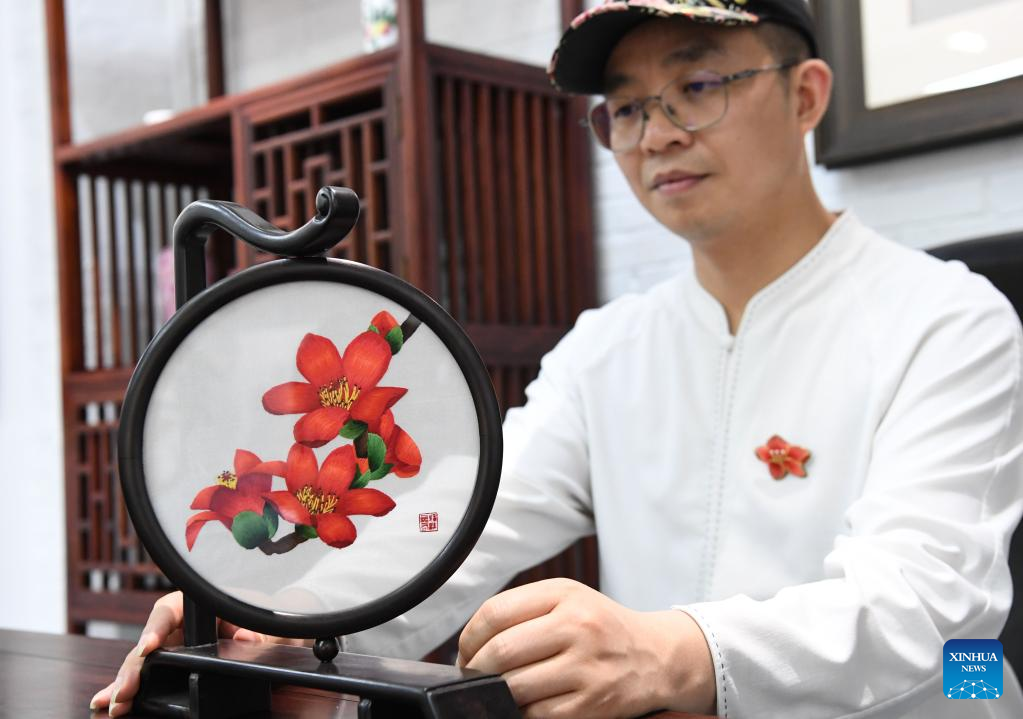
Wang Xinyuan introduces a piece of Guangzhou embroidery artwork on silk cotton flowers at his studio in Liwan District of Guangzhou, south China's Guangdong Province, April 4, 2023. Cantonese embroidery is one of the four famous embroideries in China. Guangzhou embroidery, part of Cantonese embroidery, dates back to the Tang Dynasty (618-907) and has a history of more than 1,000 years. Boasting of over 30 kinds of stitches, Guangzhou embroidery is well known for complicated composition, vivid image, rich colour and lustre, and varied styles. In May of 2006, it was listed as one of the national-level intangible cultural heritages in China. Wang Xinyuan, a representative inheritor of Guangzhou embroidery, has been engaged in the walk for over 20 years. He not only inherits the tradition, but also seeks for innovation.
In 1982, Wang was born in a tailor family in Wuning County of east China's Jiangxi Province. Due to the influence of his parents, he could darn his own clothes at ten years old. He started to know embroidery from his aunt when he was thirteen and systematically studied Guangzhou embroidery at a Cantonese embroidery institute in Foshan of south China's Guangdong in 2001. Three years of work-study life made him fall in love with the art. "It's not only that I choose Guangzhou embroidery, it also chooses me, " Wang said.
Over the years, Wang has tried to make his own way in the inheriting of the craft, creating artworks with distinguishing styles. In his embroideries, he has adopted methods which are usually used in photography, oil paintings and traditional Chinese paintings. Besides traditional themes such as flowers and birds, silk cotton and lichee, Wang has also created Guangzhou embroidery on bronze wares, famous paintings and portraits.
His efforts and exploration have been widely recognized with his artworks winning gold medals time and again in national-level competitions. In order to integrate the craft into people's daily life, Wang also sets up a team to develop creative cultural products on Guangzhou embroidery such as desk lamps, facial masks, scarves, ties, fans and pillows, making the craft affordable by common people.
In recent years, Wang has brought his craft to over ten schools to give lessons for students there, cultivating their love and taste for the traditional art. He has also accepted apprentices in rural areas, helped women start their own careers, and taught skills for people with disabilities.
For him, passing on Guangzhou embroidery needs to combine modern concepts with the tradition, "It's only innovation that gives life to the traditional art," Wang said. (Xinhua/Deng Hua)
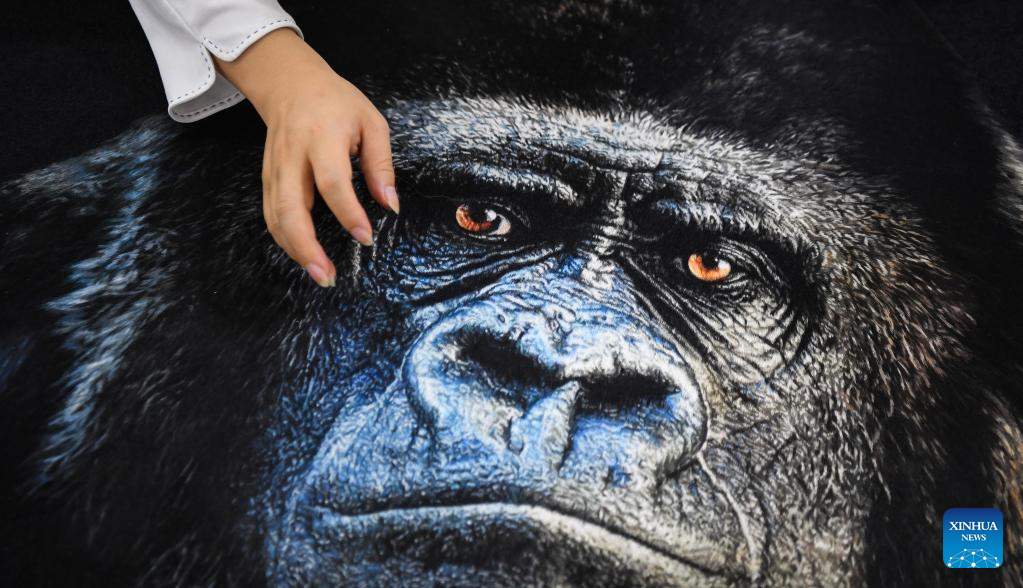
Wang Xinyuan makes a piece of Guangzhou embroidery artwork on gorilla at his studio in Liwan District of Guangzhou, south China's Guangdong Province, April 4, 2023. Cantonese embroidery is one of the four famous embroideries in China. Guangzhou embroidery, part of Cantonese embroidery, dates back to the Tang Dynasty (618-907) and has a history of more than 1,000 years.
Boasting of over 30 kinds of stitches, Guangzhou embroidery is well known for complicated composition, vivid image, rich colour and lustre, and varied styles. In May of 2006, it was listed as one of the national-level intangible cultural heritages in China.
Wang Xinyuan, a representative inheritor of Guangzhou embroidery, has been engaged in the walk for over 20 years. He not only inherits the tradition, but also seeks for innovation.
In 1982, Wang was born in a tailor family in Wuning County of east China's Jiangxi Province. Due to the influence of his parents, he could darn his own clothes at ten years old. He started to know embroidery from his aunt when he was thirteen and systematically studied Guangzhou embroidery at a Cantonese embroidery institute in Foshan of south China's Guangdong in 2001. Three years of work-study life made him fall in love with the art. "It's not only that I choose Guangzhou embroidery, it also chooses me, " Wang said.
Over the years, Wang has tried to make his own way in the inheriting of the craft, creating artworks with distinguishing styles. In his embroideries, he has adopted methods which are usually used in photography, oil paintings and traditional Chinese paintings. Besides traditional themes such as flowers and birds, silk cotton and lichee, Wang has also created Guangzhou embroidery on bronze wares, famous paintings and portraits.
His efforts and exploration have been widely recognized with his artworks winning gold medals time and again in national-level competitions. In order to integrate the craft into people's daily life, Wang also sets up a team to develop creative cultural products on Guangzhou embroidery such as desk lamps, facial masks, scarves, ties, fans and pillows, making the craft affordable by common people.
In recent years, Wang has brought his craft to over ten schools to give lessons for students there, cultivating their love and taste for the traditional art. He has also accepted apprentices in rural areas, helped women start their own careers, and taught skills for people with disabilities.
For him, passing on Guangzhou embroidery needs to combine modern concepts with the tradition, "It's only innovation that gives life to the traditional art," Wang said. (Xinhua/Deng Hua)
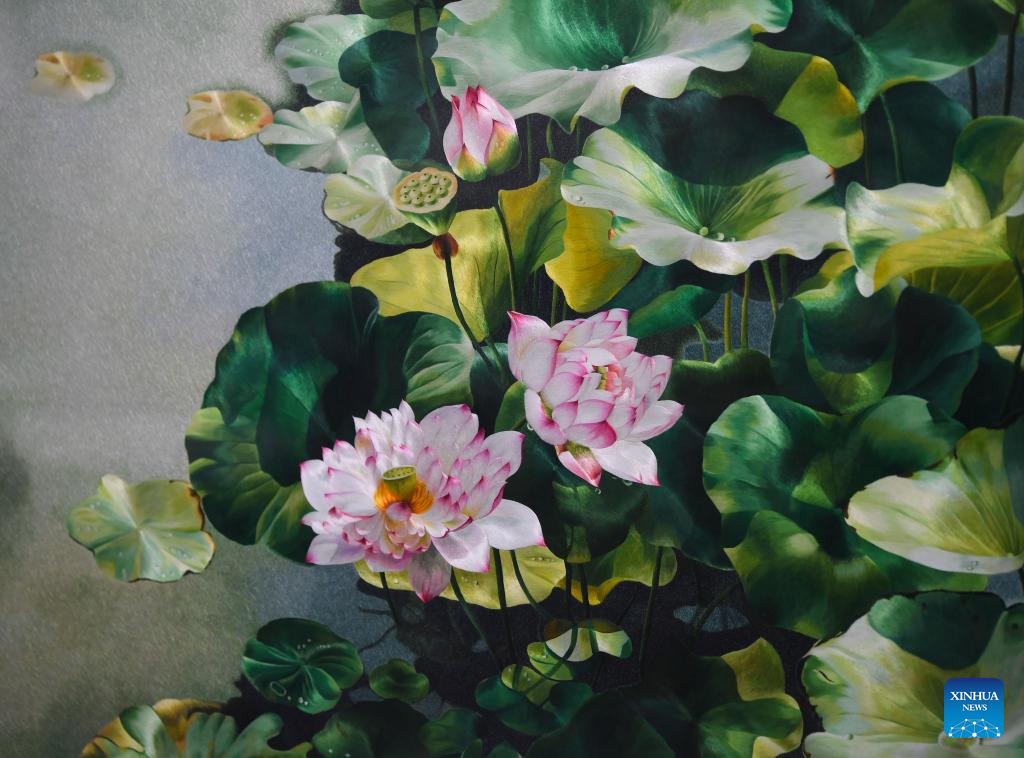
This photo taken on April 4, 2023 shows a piece of Guangzhou embroidery artwork by Wang Xinyuan in Guangzhou, south China's Guangdong Province. Cantonese embroidery is one of the four famous embroideries in China. Guangzhou embroidery, part of Cantonese embroidery, dates back to the Tang Dynasty (618-907) and has a history of more than 1,000 years.
Boasting of over 30 kinds of stitches, Guangzhou embroidery is well known for complicated composition, vivid image, rich colour and lustre, and varied styles. In May of 2006, it was listed as one of the national-level intangible cultural heritages in China.
Wang Xinyuan, a representative inheritor of Guangzhou embroidery, has been engaged in the walk for over 20 years. He not only inherits the tradition, but also seeks for innovation.
In 1982, Wang was born in a tailor family in Wuning County of east China's Jiangxi Province. Due to the influence of his parents, he could darn his own clothes at ten years old. He started to know embroidery from his aunt when he was thirteen and systematically studied Guangzhou embroidery at a Cantonese embroidery institute in Foshan of south China's Guangdong in 2001. Three years of work-study life made him fall in love with the art. "It's not only that I choose Guangzhou embroidery, it also chooses me, " Wang said.
Over the years, Wang has tried to make his own way in the inheriting of the craft, creating artworks with distinguishing styles. In his embroideries, he has adopted methods which are usually used in photography, oil paintings and traditional Chinese paintings. Besides traditional themes such as flowers and birds, silk cotton and lichee, Wang has also created Guangzhou embroidery on bronze wares, famous paintings and portraits.
His efforts and exploration have been widely recognized with his artworks winning gold medals time and again in national-level competitions. In order to integrate the craft into people's daily life, Wang also sets up a team to develop creative cultural products on Guangzhou embroidery such as desk lamps, facial masks, scarves, ties, fans and pillows, making the craft affordable by common people.
In recent years, Wang has brought his craft to over ten schools to give lessons for students there, cultivating their love and taste for the traditional art. He has also accepted apprentices in rural areas, helped women start their own careers, and taught skills for people with disabilities.
For him, passing on Guangzhou embroidery needs to combine modern concepts with the tradition, "It's only innovation that gives life to the traditional art," Wang said. (Xinhua/Deng Hua)
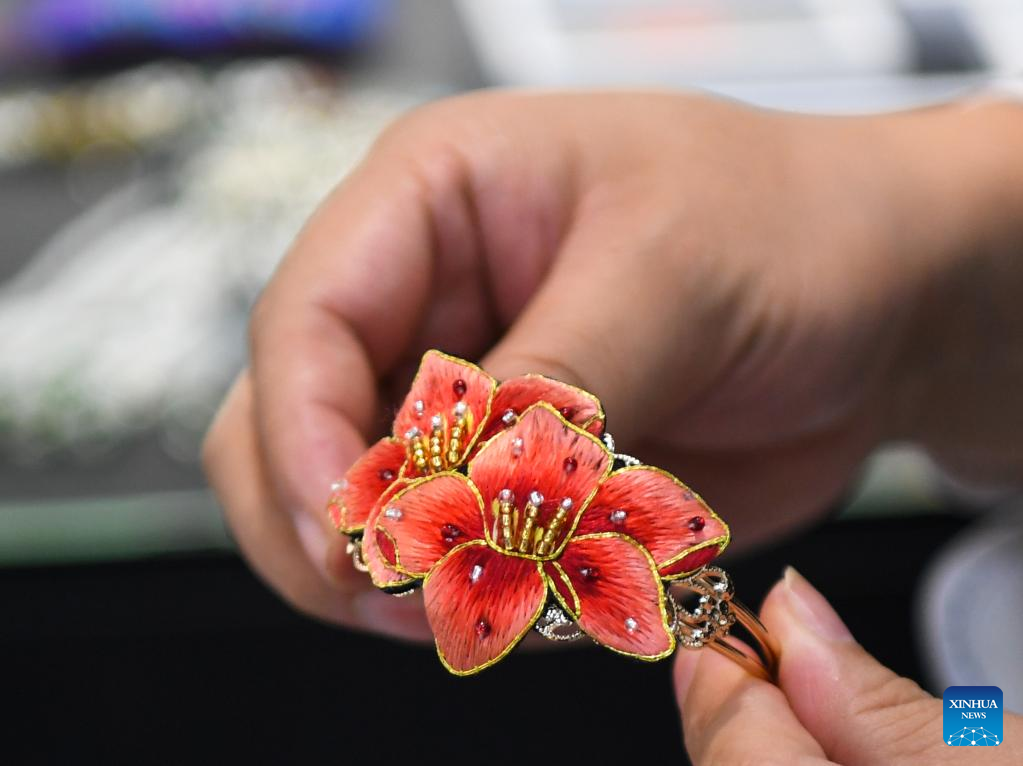
Wang Xinyuan shows a creative cultural product of Guangzhou embroidery at his studio in Liwan District of Guangzhou, south China's Guangdong Province, Dec. 6, 2022. Cantonese embroidery is one of the four famous embroideries in China. Guangzhou embroidery, part of Cantonese embroidery, dates back to the Tang Dynasty (618-907) and has a history of more than 1,000 years.
Boasting of over 30 kinds of stitches, Guangzhou embroidery is well known for complicated composition, vivid image, rich colour and lustre, and varied styles. In May of 2006, it was listed as one of the national-level intangible cultural heritages in China.
Wang Xinyuan, a representative inheritor of Guangzhou embroidery, has been engaged in the walk for over 20 years. He not only inherits the tradition, but also seeks for innovation.
In 1982, Wang was born in a tailor family in Wuning County of east China's Jiangxi Province. Due to the influence of his parents, he could darn his own clothes at ten years old. He started to know embroidery from his aunt when he was thirteen and systematically studied Guangzhou embroidery at a Cantonese embroidery institute in Foshan of south China's Guangdong in 2001. Three years of work-study life made him fall in love with the art. "It's not only that I choose Guangzhou embroidery, it also chooses me, " Wang said.
Over the years, Wang has tried to make his own way in the inheriting of the craft, creating artworks with distinguishing styles. In his embroideries, he has adopted methods which are usually used in photography, oil paintings and traditional Chinese paintings. Besides traditional themes such as flowers and birds, silk cotton and lichee, Wang has also created Guangzhou embroidery on bronze wares, famous paintings and portraits.
His efforts and exploration have been widely recognized with his artworks winning gold medals time and again in national-level competitions. In order to integrate the craft into people's daily life, Wang also sets up a team to develop creative cultural products on Guangzhou embroidery such as desk lamps, facial masks, scarves, ties, fans and pillows, making the craft affordable by common people.
In recent years, Wang has brought his craft to over ten schools to give lessons for students there, cultivating their love and taste for the traditional art. He has also accepted apprentices in rural areas, helped women start their own careers, and taught skills for people with disabilities.
For him, passing on Guangzhou embroidery needs to combine modern concepts with the tradition, "It's only innovation that gives life to the traditional art," Wang said. (Xinhua/Deng Hua)
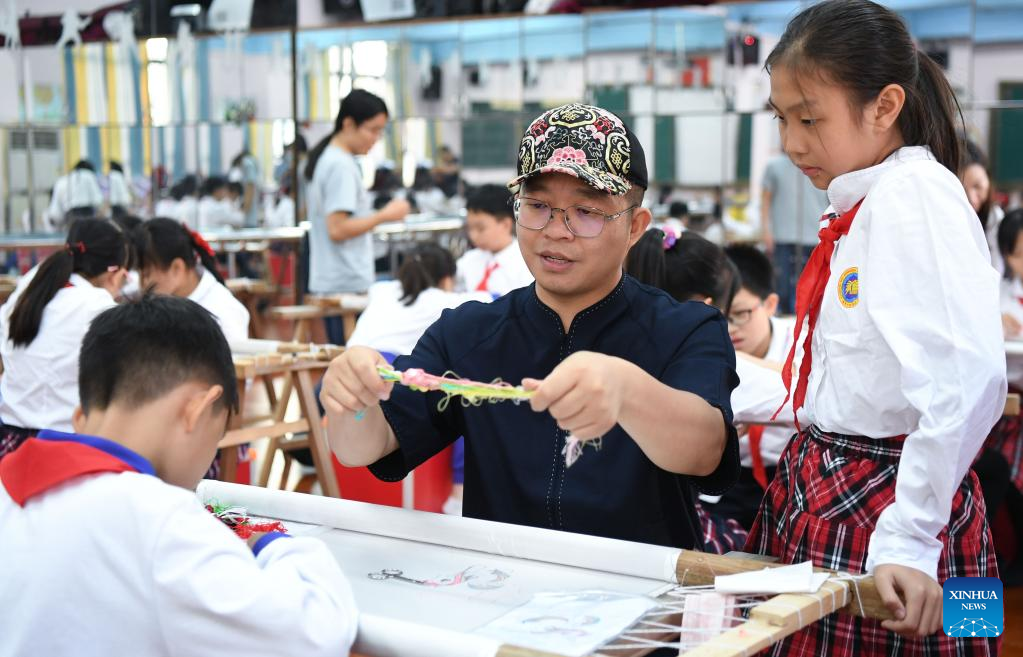
Wang Xinyuan guides students in a class on Guangzhou embroidery at a primary school in Liwan District of Guangzhou, south China's Guangdong Province, Oct. 12, 2022. Cantonese embroidery is one of the four famous embroideries in China. Guangzhou embroidery, part of Cantonese embroidery, dates back to the Tang Dynasty (618-907) and has a history of more than 1,000 years.
Boasting of over 30 kinds of stitches, Guangzhou embroidery is well known for complicated composition, vivid image, rich colour and lustre, and varied styles. In May of 2006, it was listed as one of the national-level intangible cultural heritages in China.
Wang Xinyuan, a representative inheritor of Guangzhou embroidery, has been engaged in the walk for over 20 years. He not only inherits the tradition, but also seeks for innovation.
In 1982, Wang was born in a tailor family in Wuning County of east China's Jiangxi Province. Due to the influence of his parents, he could darn his own clothes at ten years old. He started to know embroidery from his aunt when he was thirteen and systematically studied Guangzhou embroidery at a Cantonese embroidery institute in Foshan of south China's Guangdong in 2001. Three years of work-study life made him fall in love with the art. "It's not only that I choose Guangzhou embroidery, it also chooses me, " Wang said.
Over the years, Wang has tried to make his own way in the inheriting of the craft, creating artworks with distinguishing styles. In his embroideries, he has adopted methods which are usually used in photography, oil paintings and traditional Chinese paintings. Besides traditional themes such as flowers and birds, silk cotton and lichee, Wang has also created Guangzhou embroidery on bronze wares, famous paintings and portraits.
His efforts and exploration have been widely recognized with his artworks winning gold medals time and again in national-level competitions. In order to integrate the craft into people's daily life, Wang also sets up a team to develop creative cultural products on Guangzhou embroidery such as desk lamps, facial masks, scarves, ties, fans and pillows, making the craft affordable by common people.
In recent years, Wang has brought his craft to over ten schools to give lessons for students there, cultivating their love and taste for the traditional art. He has also accepted apprentices in rural areas, helped women start their own careers, and taught skills for people with disabilities.
For him, passing on Guangzhou embroidery needs to combine modern concepts with the tradition, "It's only innovation that gives life to the traditional art," Wang said. (Xinhua/Deng Hua)
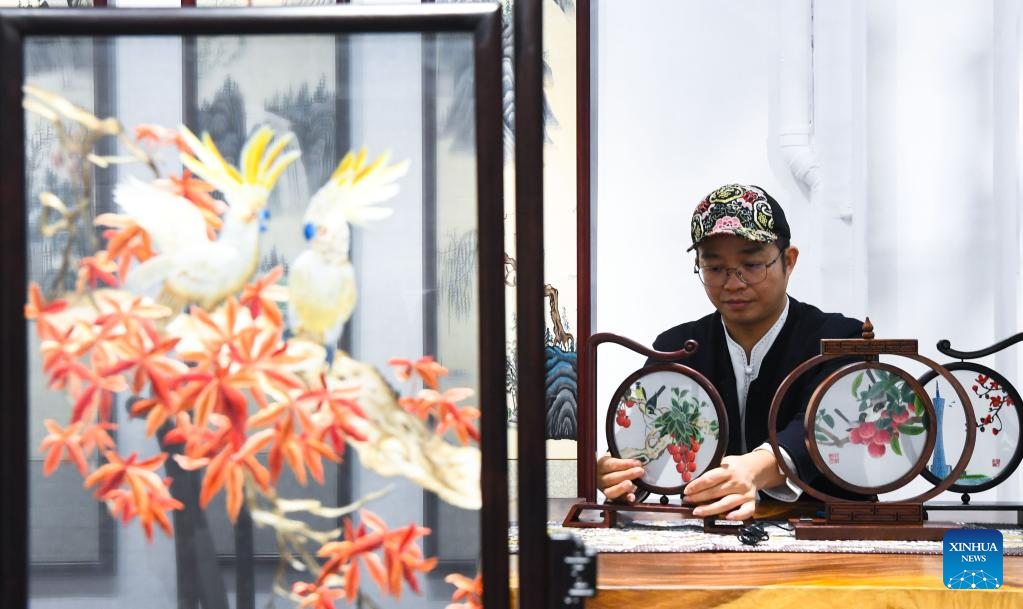
Wang Xinyuan arranges Guangzhou embroidery artworks at his studio in Liwan District of Guangzhou, south China's Guangdong Province, Dec. 6, 2022. Cantonese embroidery is one of the four famous embroideries in China. Guangzhou embroidery, part of Cantonese embroidery, dates back to the Tang Dynasty (618-907) and has a history of more than 1,000 years.
Boasting of over 30 kinds of stitches, Guangzhou embroidery is well known for complicated composition, vivid image, rich colour and lustre, and varied styles. In May of 2006, it was listed as one of the national-level intangible cultural heritages in China.
Wang Xinyuan, a representative inheritor of Guangzhou embroidery, has been engaged in the walk for over 20 years. He not only inherits the tradition, but also seeks for innovation.
In 1982, Wang was born in a tailor family in Wuning County of east China's Jiangxi Province. Due to the influence of his parents, he could darn his own clothes at ten years old. He started to know embroidery from his aunt when he was thirteen and systematically studied Guangzhou embroidery at a Cantonese embroidery institute in Foshan of south China's Guangdong in 2001. Three years of work-study life made him fall in love with the art. "It's not only that I choose Guangzhou embroidery, it also chooses me, " Wang said.
Over the years, Wang has tried to make his own way in the inheriting of the craft, creating artworks with distinguishing styles. In his embroideries, he has adopted methods which are usually used in photography, oil paintings and traditional Chinese paintings. Besides traditional themes such as flowers and birds, silk cotton and lichee, Wang has also created Guangzhou embroidery on bronze wares, famous paintings and portraits.
His efforts and exploration have been widely recognized with his artworks winning gold medals time and again in national-level competitions. In order to integrate the craft into people's daily life, Wang also sets up a team to develop creative cultural products on Guangzhou embroidery such as desk lamps, facial masks, scarves, ties, fans and pillows, making the craft affordable by common people.
In recent years, Wang has brought his craft to over ten schools to give lessons for students there, cultivating their love and taste for the traditional art. He has also accepted apprentices in rural areas, helped women start their own careers, and taught skills for people with disabilities.
For him, passing on Guangzhou embroidery needs to combine modern concepts with the tradition, "It's only innovation that gives life to the traditional art," Wang said. (Xinhua/Deng Hua)
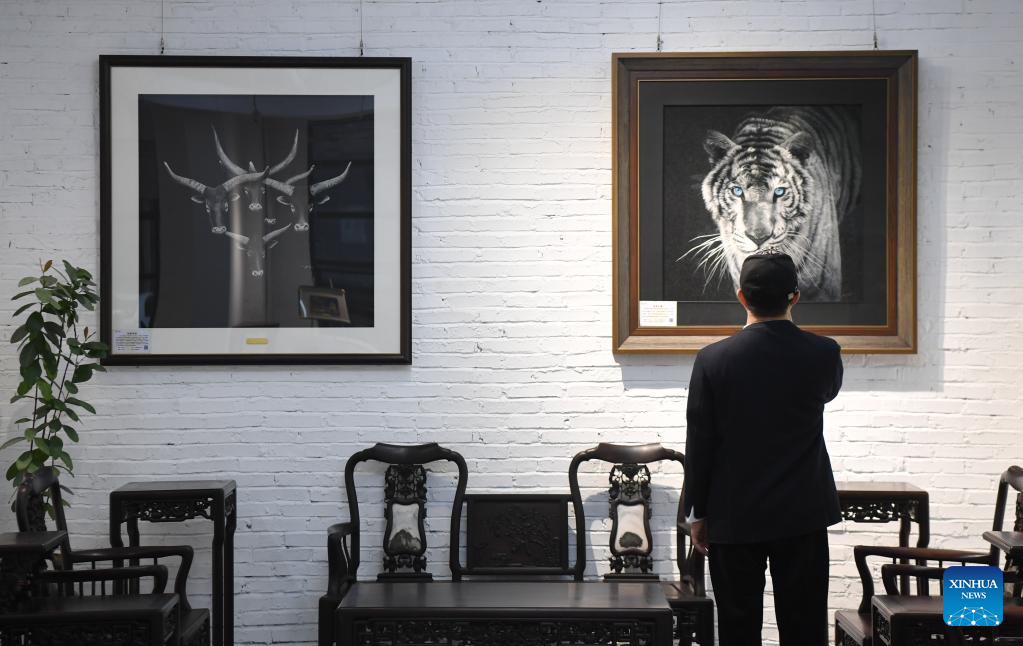
Wang Xinyuan looks at a piece of Guangzhou embroidery artwork at his studio in Liwan District of Guangzhou, south China's Guangdong Province, Dec. 6, 2022. Cantonese embroidery is one of the four famous embroideries in China. Guangzhou embroidery, part of Cantonese embroidery, dates back to the Tang Dynasty (618-907) and has a history of more than 1,000 years.
Boasting of over 30 kinds of stitches, Guangzhou embroidery is well known for complicated composition, vivid image, rich colour and lustre, and varied styles. In May of 2006, it was listed as one of the national-level intangible cultural heritages in China.
Wang Xinyuan, a representative inheritor of Guangzhou embroidery, has been engaged in the walk for over 20 years. He not only inherits the tradition, but also seeks for innovation.
In 1982, Wang was born in a tailor family in Wuning County of east China's Jiangxi Province. Due to the influence of his parents, he could darn his own clothes at ten years old. He started to know embroidery from his aunt when he was thirteen and systematically studied Guangzhou embroidery at a Cantonese embroidery institute in Foshan of south China's Guangdong in 2001. Three years of work-study life made him fall in love with the art. "It's not only that I choose Guangzhou embroidery, it also chooses me, " Wang said.
Over the years, Wang has tried to make his own way in the inheriting of the craft, creating artworks with distinguishing styles. In his embroideries, he has adopted methods which are usually used in photography, oil paintings and traditional Chinese paintings. Besides traditional themes such as flowers and birds, silk cotton and lichee, Wang has also created Guangzhou embroidery on bronze wares, famous paintings and portraits.
His efforts and exploration have been widely recognized with his artworks winning gold medals time and again in national-level competitions. In order to integrate the craft into people's daily life, Wang also sets up a team to develop creative cultural products on Guangzhou embroidery such as desk lamps, facial masks, scarves, ties, fans and pillows, making the craft affordable by common people.
In recent years, Wang has brought his craft to over ten schools to give lessons for students there, cultivating their love and taste for the traditional art. He has also accepted apprentices in rural areas, helped women start their own careers, and taught skills for people with disabilities.
For him, passing on Guangzhou embroidery needs to combine modern concepts with the tradition, "It's only innovation that gives life to the traditional art," Wang said. (Xinhua/Deng Hua)
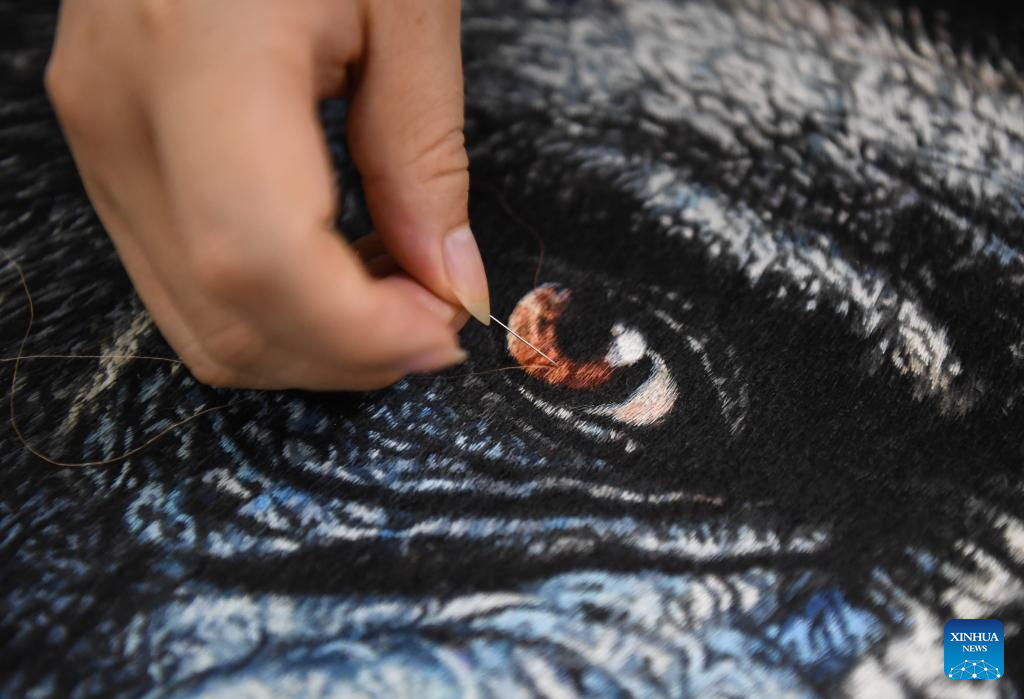
Wang Xinyuan makes a piece of Guangzhou embroidery artwork on gorilla at his studio in Liwan District of Guangzhou, south China's Guangdong Province, April 4, 2023. Cantonese embroidery is one of the four famous embroideries in China. Guangzhou embroidery, part of Cantonese embroidery, dates back to the Tang Dynasty (618-907) and has a history of more than 1,000 years.
Boasting of over 30 kinds of stitches, Guangzhou embroidery is well known for complicated composition, vivid image, rich colour and lustre, and varied styles. In May of 2006, it was listed as one of the national-level intangible cultural heritages in China.
Wang Xinyuan, a representative inheritor of Guangzhou embroidery, has been engaged in the walk for over 20 years. He not only inherits the tradition, but also seeks for innovation.
In 1982, Wang was born in a tailor family in Wuning County of east China's Jiangxi Province. Due to the influence of his parents, he could darn his own clothes at ten years old. He started to know embroidery from his aunt when he was thirteen and systematically studied Guangzhou embroidery at a Cantonese embroidery institute in Foshan of south China's Guangdong in 2001. Three years of work-study life made him fall in love with the art. "It's not only that I choose Guangzhou embroidery, it also chooses me, " Wang said.
Over the years, Wang has tried to make his own way in the inheriting of the craft, creating artworks with distinguishing styles. In his embroideries, he has adopted methods which are usually used in photography, oil paintings and traditional Chinese paintings. Besides traditional themes such as flowers and birds, silk cotton and lichee, Wang has also created Guangzhou embroidery on bronze wares, famous paintings and portraits.
His efforts and exploration have been widely recognized with his artworks winning gold medals time and again in national-level competitions. In order to integrate the craft into people's daily life, Wang also sets up a team to develop creative cultural products on Guangzhou embroidery such as desk lamps, facial masks, scarves, ties, fans and pillows, making the craft affordable by common people.
In recent years, Wang has brought his craft to over ten schools to give lessons for students there, cultivating their love and taste for the traditional art. He has also accepted apprentices in rural areas, helped women start their own careers, and taught skills for people with disabilities.
For him, passing on Guangzhou embroidery needs to combine modern concepts with the tradition, "It's only innovation that gives life to the traditional art," Wang said. (Xinhua/Deng Hua)
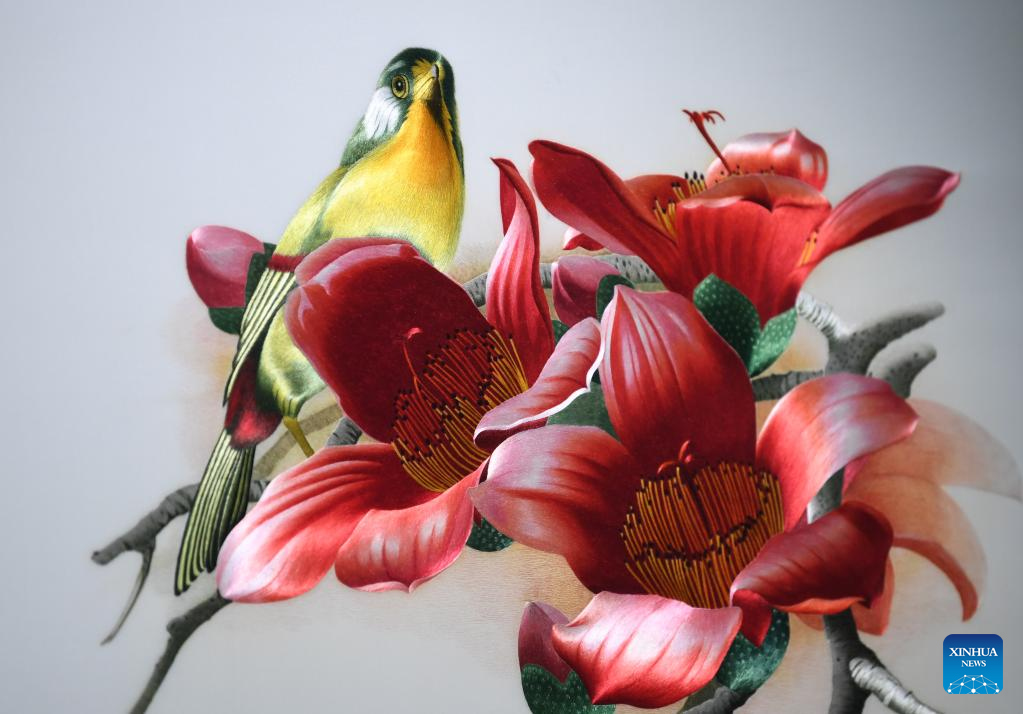
This photo taken on April 4, 2023 shows a piece of Guangzhou embroidery artwork by Wang Xinyuan in Guangzhou, south China's Guangdong Province. Cantonese embroidery is one of the four famous embroideries in China. Guangzhou embroidery, part of Cantonese embroidery, dates back to the Tang Dynasty (618-907) and has a history of more than 1,000 years.
Boasting of over 30 kinds of stitches, Guangzhou embroidery is well known for complicated composition, vivid image, rich colour and lustre, and varied styles. In May of 2006, it was listed as one of the national-level intangible cultural heritages in China.
Wang Xinyuan, a representative inheritor of Guangzhou embroidery, has been engaged in the walk for over 20 years. He not only inherits the tradition, but also seeks for innovation.
In 1982, Wang was born in a tailor family in Wuning County of east China's Jiangxi Province. Due to the influence of his parents, he could darn his own clothes at ten years old. He started to know embroidery from his aunt when he was thirteen and systematically studied Guangzhou embroidery at a Cantonese embroidery institute in Foshan of south China's Guangdong in 2001. Three years of work-study life made him fall in love with the art. "It's not only that I choose Guangzhou embroidery, it also chooses me, " Wang said.
Over the years, Wang has tried to make his own way in the inheriting of the craft, creating artworks with distinguishing styles. In his embroideries, he has adopted methods which are usually used in photography, oil paintings and traditional Chinese paintings. Besides traditional themes such as flowers and birds, silk cotton and lichee, Wang has also created Guangzhou embroidery on bronze wares, famous paintings and portraits.
His efforts and exploration have been widely recognized with his artworks winning gold medals time and again in national-level competitions. In order to integrate the craft into people's daily life, Wang also sets up a team to develop creative cultural products on Guangzhou embroidery such as desk lamps, facial masks, scarves, ties, fans and pillows, making the craft affordable by common people.
In recent years, Wang has brought his craft to over ten schools to give lessons for students there, cultivating their love and taste for the traditional art. He has also accepted apprentices in rural areas, helped women start their own careers, and taught skills for people with disabilities.
For him, passing on Guangzhou embroidery needs to combine modern concepts with the tradition, "It's only innovation that gives life to the traditional art," Wang said. (Xinhua/Deng Hua)
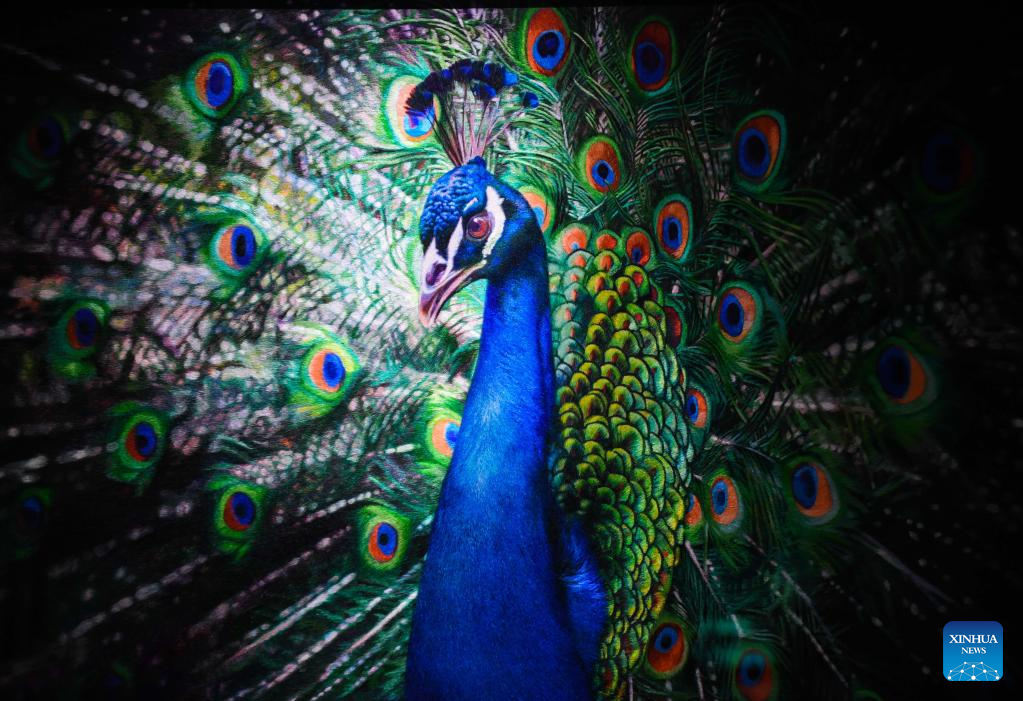
This photo taken on April 4, 2023 shows a piece of Guangzhou embroidery artwork by Wang Xinyuan in Guangzhou, south China's Guangdong Province. Cantonese embroidery is one of the four famous embroideries in China. Guangzhou embroidery, part of Cantonese embroidery, dates back to the Tang Dynasty (618-907) and has a history of more than 1,000 years.
Boasting of over 30 kinds of stitches, Guangzhou embroidery is well known for complicated composition, vivid image, rich colour and lustre, and varied styles. In May of 2006, it was listed as one of the national-level intangible cultural heritages in China.
Wang Xinyuan, a representative inheritor of Guangzhou embroidery, has been engaged in the walk for over 20 years. He not only inherits the tradition, but also seeks for innovation.
In 1982, Wang was born in a tailor family in Wuning County of east China's Jiangxi Province. Due to the influence of his parents, he could darn his own clothes at ten years old. He started to know embroidery from his aunt when he was thirteen and systematically studied Guangzhou embroidery at a Cantonese embroidery institute in Foshan of south China's Guangdong in 2001. Three years of work-study life made him fall in love with the art. "It's not only that I choose Guangzhou embroidery, it also chooses me, " Wang said.
Over the years, Wang has tried to make his own way in the inheriting of the craft, creating artworks with distinguishing styles. In his embroideries, he has adopted methods which are usually used in photography, oil paintings and traditional Chinese paintings. Besides traditional themes such as flowers and birds, silk cotton and lichee, Wang has also created Guangzhou embroidery on bronze wares, famous paintings and portraits.
His efforts and exploration have been widely recognized with his artworks winning gold medals time and again in national-level competitions. In order to integrate the craft into people's daily life, Wang also sets up a team to develop creative cultural products on Guangzhou embroidery such as desk lamps, facial masks, scarves, ties, fans and pillows, making the craft affordable by common people.
In recent years, Wang has brought his craft to over ten schools to give lessons for students there, cultivating their love and taste for the traditional art. He has also accepted apprentices in rural areas, helped women start their own careers, and taught skills for people with disabilities.
For him, passing on Guangzhou embroidery needs to combine modern concepts with the tradition, "It's only innovation that gives life to the traditional art," Wang said. (Xinhua/Deng Hua)
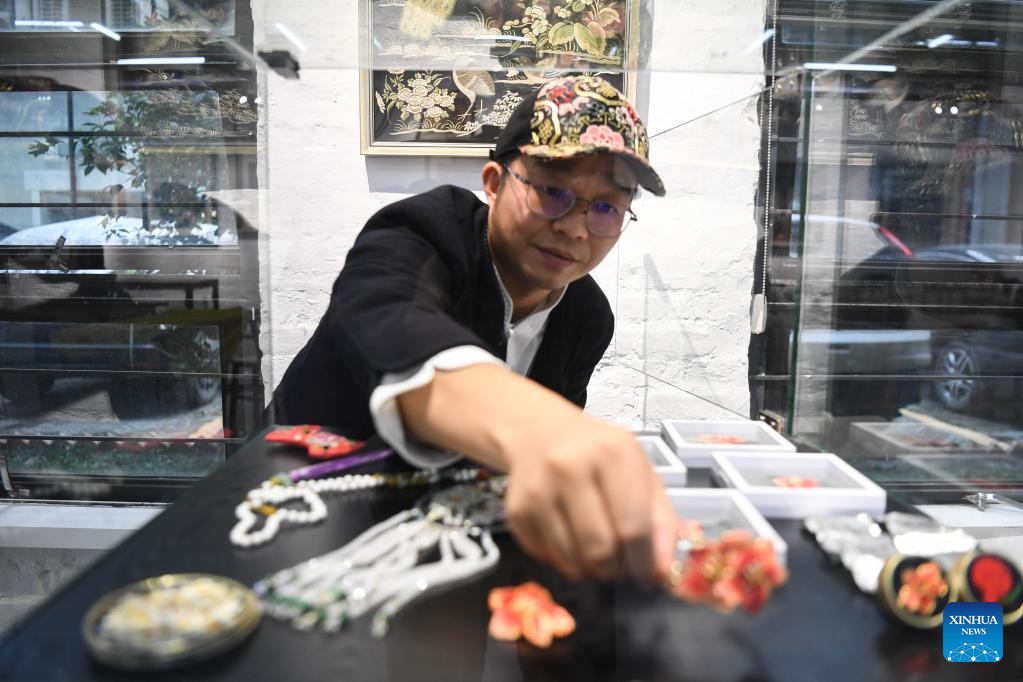
Wang Xinyuan arranges creative cultural products of Guangzhou embroidery at his studio in Liwan District of Guangzhou, south China's Guangdong Province, Dec. 6, 2022. Cantonese embroidery is one of the four famous embroideries in China. Guangzhou embroidery, part of Cantonese embroidery, dates back to the Tang Dynasty (618-907) and has a history of more than 1,000 years.
Boasting of over 30 kinds of stitches, Guangzhou embroidery is well known for complicated composition, vivid image, rich colour and lustre, and varied styles. In May of 2006, it was listed as one of the national-level intangible cultural heritages in China.
Wang Xinyuan, a representative inheritor of Guangzhou embroidery, has been engaged in the walk for over 20 years. He not only inherits the tradition, but also seeks for innovation.
In 1982, Wang was born in a tailor family in Wuning County of east China's Jiangxi Province. Due to the influence of his parents, he could darn his own clothes at ten years old. He started to know embroidery from his aunt when he was thirteen and systematically studied Guangzhou embroidery at a Cantonese embroidery institute in Foshan of south China's Guangdong in 2001. Three years of work-study life made him fall in love with the art. "It's not only that I choose Guangzhou embroidery, it also chooses me, " Wang said.
Over the years, Wang has tried to make his own way in the inheriting of the craft, creating artworks with distinguishing styles. In his embroideries, he has adopted methods which are usually used in photography, oil paintings and traditional Chinese paintings. Besides traditional themes such as flowers and birds, silk cotton and lichee, Wang has also created Guangzhou embroidery on bronze wares, famous paintings and portraits.
His efforts and exploration have been widely recognized with his artworks winning gold medals time and again in national-level competitions. In order to integrate the craft into people's daily life, Wang also sets up a team to develop creative cultural products on Guangzhou embroidery such as desk lamps, facial masks, scarves, ties, fans and pillows, making the craft affordable by common people.
In recent years, Wang has brought his craft to over ten schools to give lessons for students there, cultivating their love and taste for the traditional art. He has also accepted apprentices in rural areas, helped women start their own careers, and taught skills for people with disabilities.
For him, passing on Guangzhou embroidery needs to combine modern concepts with the tradition, "It's only innovation that gives life to the traditional art," Wang said. (Xinhua/Deng Hua)
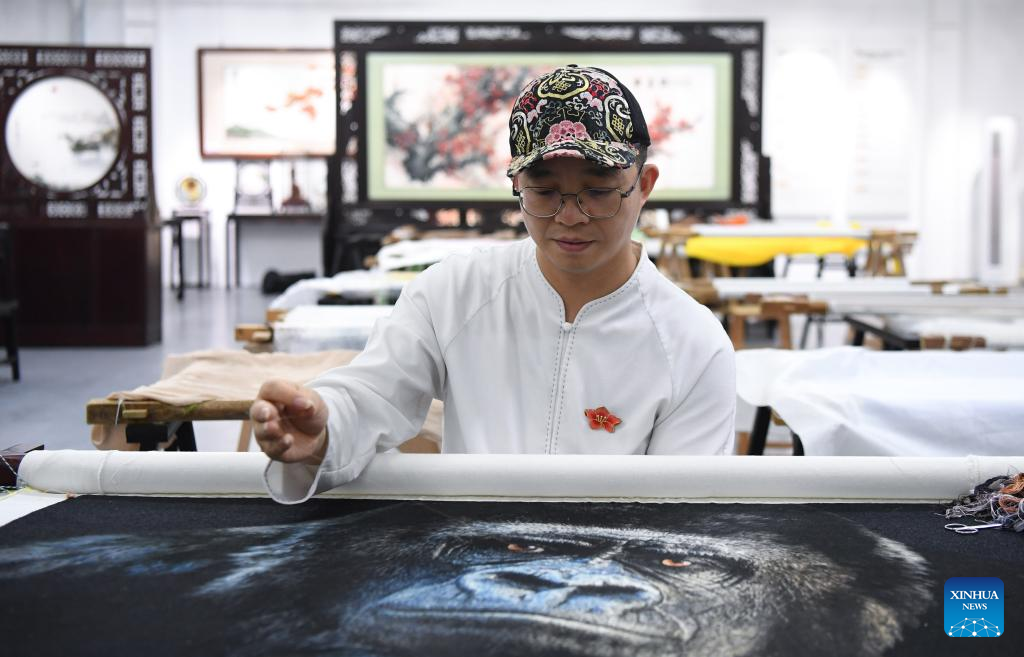
Wang Xinyuan makes a piece of Guangzhou embroidery artwork on gorilla at his studio in Liwan District of Guangzhou, south China's Guangdong Province, April 4, 2023. Cantonese embroidery is one of the four famous embroideries in China. Guangzhou embroidery, part of Cantonese embroidery, dates back to the Tang Dynasty (618-907) and has a history of more than 1,000 years.
Boasting of over 30 kinds of stitches, Guangzhou embroidery is well known for complicated composition, vivid image, rich colour and lustre, and varied styles. In May of 2006, it was listed as one of the national-level intangible cultural heritages in China.
Wang Xinyuan, a representative inheritor of Guangzhou embroidery, has been engaged in the walk for over 20 years. He not only inherits the tradition, but also seeks for innovation.
In 1982, Wang was born in a tailor family in Wuning County of east China's Jiangxi Province. Due to the influence of his parents, he could darn his own clothes at ten years old. He started to know embroidery from his aunt when he was thirteen and systematically studied Guangzhou embroidery at a Cantonese embroidery institute in Foshan of south China's Guangdong in 2001. Three years of work-study life made him fall in love with the art. "It's not only that I choose Guangzhou embroidery, it also chooses me, " Wang said.
Over the years, Wang has tried to make his own way in the inheriting of the craft, creating artworks with distinguishing styles. In his embroideries, he has adopted methods which are usually used in photography, oil paintings and traditional Chinese paintings. Besides traditional themes such as flowers and birds, silk cotton and lichee, Wang has also created Guangzhou embroidery on bronze wares, famous paintings and portraits.
His efforts and exploration have been widely recognized with his artworks winning gold medals time and again in national-level competitions. In order to integrate the craft into people's daily life, Wang also sets up a team to develop creative cultural products on Guangzhou embroidery such as desk lamps, facial masks, scarves, ties, fans and pillows, making the craft affordable by common people.
In recent years, Wang has brought his craft to over ten schools to give lessons for students there, cultivating their love and taste for the traditional art. He has also accepted apprentices in rural areas, helped women start their own careers, and taught skills for people with disabilities.
For him, passing on Guangzhou embroidery needs to combine modern concepts with the tradition, "It's only innovation that gives life to the traditional art," Wang said. (Xinhua/Deng Hua)
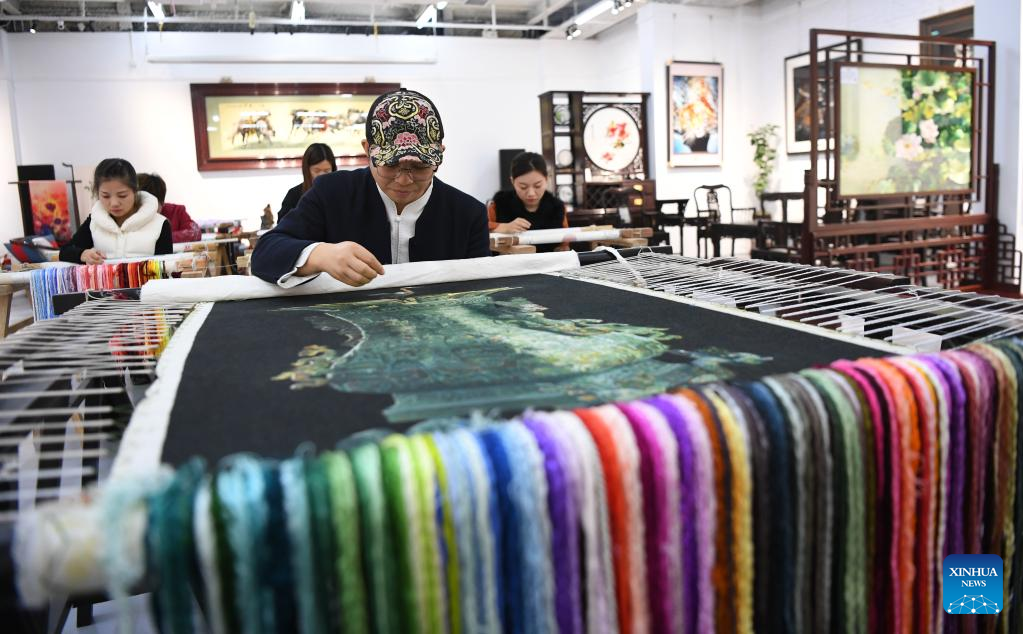
Wang Xinyuan makes a piece of Guangzhou embroidery artwork on bronze ware at his studio in Liwan District of Guangzhou, south China's Guangdong Province, Dec. 6, 2022. Cantonese embroidery is one of the four famous embroideries in China. Guangzhou embroidery, part of Cantonese embroidery, dates back to the Tang Dynasty (618-907) and has a history of more than 1,000 years.
Boasting of over 30 kinds of stitches, Guangzhou embroidery is well known for complicated composition, vivid image, rich colour and lustre, and varied styles. In May of 2006, it was listed as one of the national-level intangible cultural heritages in China.
Wang Xinyuan, a representative inheritor of Guangzhou embroidery, has been engaged in the walk for over 20 years. He not only inherits the tradition, but also seeks for innovation.
In 1982, Wang was born in a tailor family in Wuning County of east China's Jiangxi Province. Due to the influence of his parents, he could darn his own clothes at ten years old. He started to know embroidery from his aunt when he was thirteen and systematically studied Guangzhou embroidery at a Cantonese embroidery institute in Foshan of south China's Guangdong in 2001. Three years of work-study life made him fall in love with the art. "It's not only that I choose Guangzhou embroidery, it also chooses me, " Wang said.
Over the years, Wang has tried to make his own way in the inheriting of the craft, creating artworks with distinguishing styles. In his embroideries, he has adopted methods which are usually used in photography, oil paintings and traditional Chinese paintings. Besides traditional themes such as flowers and birds, silk cotton and lichee, Wang has also created Guangzhou embroidery on bronze wares, famous paintings and portraits.
His efforts and exploration have been widely recognized with his artworks winning gold medals time and again in national-level competitions. In order to integrate the craft into people's daily life, Wang also sets up a team to develop creative cultural products on Guangzhou embroidery such as desk lamps, facial masks, scarves, ties, fans and pillows, making the craft affordable by common people.
In recent years, Wang has brought his craft to over ten schools to give lessons for students there, cultivating their love and taste for the traditional art. He has also accepted apprentices in rural areas, helped women start their own careers, and taught skills for people with disabilities.
For him, passing on Guangzhou embroidery needs to combine modern concepts with the tradition, "It's only innovation that gives life to the traditional art," Wang said. (Xinhua/Deng Hua)
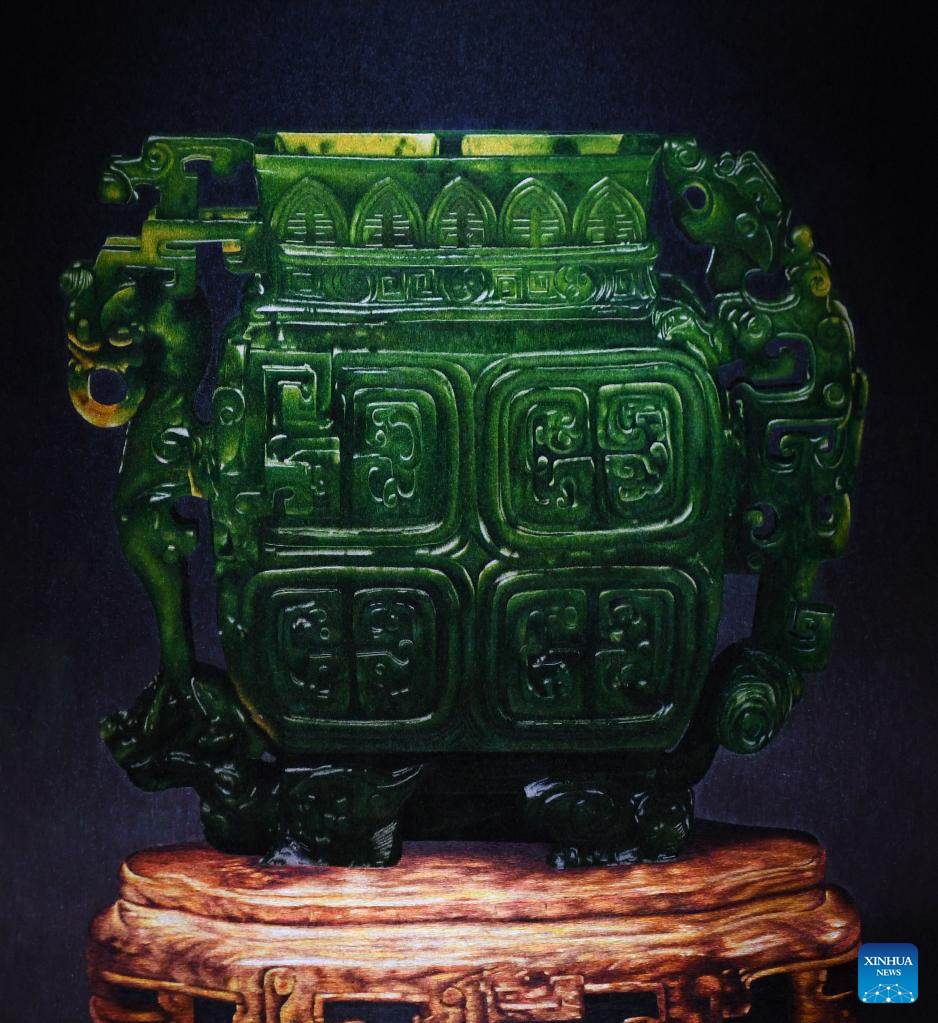
This photo taken on Dec. 6, 2022 shows a piece of Guangzhou embroidery artwork by Wang Xinyuan in Guangzhou, south China's Guangdong Province. Cantonese embroidery is one of the four famous embroideries in China. Guangzhou embroidery, part of Cantonese embroidery, dates back to the Tang Dynasty (618-907) and has a history of more than 1,000 years.
Boasting of over 30 kinds of stitches, Guangzhou embroidery is well known for complicated composition, vivid image, rich colour and lustre, and varied styles. In May of 2006, it was listed as one of the national-level intangible cultural heritages in China.
Wang Xinyuan, a representative inheritor of Guangzhou embroidery, has been engaged in the walk for over 20 years. He not only inherits the tradition, but also seeks for innovation.
In 1982, Wang was born in a tailor family in Wuning County of east China's Jiangxi Province. Due to the influence of his parents, he could darn his own clothes at ten years old. He started to know embroidery from his aunt when he was thirteen and systematically studied Guangzhou embroidery at a Cantonese embroidery institute in Foshan of south China's Guangdong in 2001. Three years of work-study life made him fall in love with the art. "It's not only that I choose Guangzhou embroidery, it also chooses me, " Wang said.
Over the years, Wang has tried to make his own way in the inheriting of the craft, creating artworks with distinguishing styles. In his embroideries, he has adopted methods which are usually used in photography, oil paintings and traditional Chinese paintings. Besides traditional themes such as flowers and birds, silk cotton and lichee, Wang has also created Guangzhou embroidery on bronze wares, famous paintings and portraits.
His efforts and exploration have been widely recognized with his artworks winning gold medals time and again in national-level competitions. In order to integrate the craft into people's daily life, Wang also sets up a team to develop creative cultural products on Guangzhou embroidery such as desk lamps, facial masks, scarves, ties, fans and pillows, making the craft affordable by common people.
In recent years, Wang has brought his craft to over ten schools to give lessons for students there, cultivating their love and taste for the traditional art. He has also accepted apprentices in rural areas, helped women start their own careers, and taught skills for people with disabilities.
For him, passing on Guangzhou embroidery needs to combine modern concepts with the tradition, "It's only innovation that gives life to the traditional art," Wang said. (Xinhua/Deng Hua)
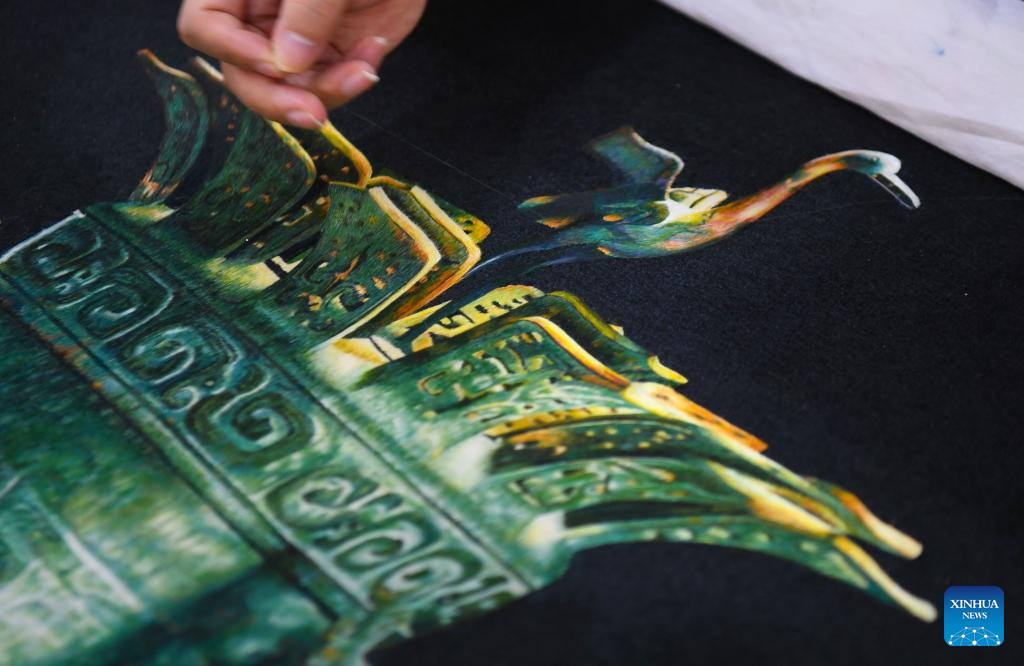
Wang Xinyuan makes a piece of Guangzhou embroidery artwork on bronze ware at his studio in Liwan District of Guangzhou, south China's Guangdong Province, Dec. 6, 2022. Cantonese embroidery is one of the four famous embroideries in China. Guangzhou embroidery, part of Cantonese embroidery, dates back to the Tang Dynasty (618-907) and has a history of more than 1,000 years.
Boasting of over 30 kinds of stitches, Guangzhou embroidery is well known for complicated composition, vivid image, rich colour and lustre, and varied styles. In May of 2006, it was listed as one of the national-level intangible cultural heritages in China.
Wang Xinyuan, a representative inheritor of Guangzhou embroidery, has been engaged in the walk for over 20 years. He not only inherits the tradition, but also seeks for innovation.
In 1982, Wang was born in a tailor family in Wuning County of east China's Jiangxi Province. Due to the influence of his parents, he could darn his own clothes at ten years old. He started to know embroidery from his aunt when he was thirteen and systematically studied Guangzhou embroidery at a Cantonese embroidery institute in Foshan of south China's Guangdong in 2001. Three years of work-study life made him fall in love with the art. "It's not only that I choose Guangzhou embroidery, it also chooses me, " Wang said.
Over the years, Wang has tried to make his own way in the inheriting of the craft, creating artworks with distinguishing styles. In his embroideries, he has adopted methods which are usually used in photography, oil paintings and traditional Chinese paintings. Besides traditional themes such as flowers and birds, silk cotton and lichee, Wang has also created Guangzhou embroidery on bronze wares, famous paintings and portraits.
His efforts and exploration have been widely recognized with his artworks winning gold medals time and again in national-level competitions. In order to integrate the craft into people's daily life, Wang also sets up a team to develop creative cultural products on Guangzhou embroidery such as desk lamps, facial masks, scarves, ties, fans and pillows, making the craft affordable by common people. In recent years, Wang has brought his craft to over ten schools to give lessons for students there, cultivating their love and taste for traditional art. He has also accepted apprentices in rural areas, helped women start their own careers, and taught skills for people with disabilities. For him, passing on Guangzhou embroidery needs to combine modern concepts with tradition, "It's only innovation that gives life to the traditional art," Wang said. (Xinhua/Deng Hua)
Time:2023-05-02 admin:China culture Views:7218

